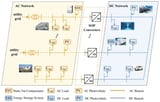Revolutionary Hybrid Networks Boost EV and Solar Integration for a Greener Grid
September 29, 2024
The increasing integration of photovoltaic systems and electric vehicles (EVs) in distribution networks is driven by fossil fuel shortages and environmental concerns.
Integrating EVs into radial distribution systems (RDSs) offers benefits such as reduced maintenance costs and enhanced environmental sustainability.
A novel scheme for battery energy storage system allocation and a slack management method have been developed to optimize capacity and economic efficiency.
The proposed model enhances network flexibility through methods like sharing energy storage systems among feeders and reactive power compensation.
Research emphasizes that operational flexibility in AC/DC hybrid networks is crucial due to the increasing variability from renewable sources and stochastic loads.
AC/DC hybrid distribution networks have emerged as a solution to enhance energy transmission efficiency and improve the integration of distributed energy resources.
These hybrid networks consist of distinct AC and DC components interconnected by soft open point (SOP) converters, enabling bidirectional power flow.
A flexibility-oriented distributionally robust chance-constrained (DRCC) model has been developed to manage uncertainties in source-load dynamics, thereby improving operational flexibility.
The authors advocate for the DRCC method as a more accurate and robust solution compared to existing stochastic and robust optimization approaches.
Findings indicate that the spotted hyena optimization algorithm (SHOA) significantly enhances system performance by reducing real power loss associated with EV charging.
Randomness in photovoltaic energy generation and disordered EV charging loads complicate voltage management, leading to economic inefficiencies.
To address the high demands of fault current interruption in DC systems, DC circuit breakers must be faster and more capable, and fault current limiters can enhance protection schemes.
Summary based on 4 sources

